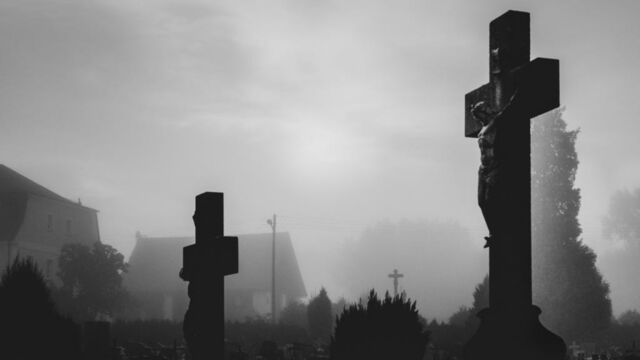Lilias Adie, accused of witchcraft, was buried in Scotland but her skull is nowhere to be found

Lilias Adie is not a name that rings a bell but her story is phenomenal. She is the only witch buried in Scotland.
Witches, crystals, astrology and magic overall have always fascinated human beings. Well maybe ‘always fascinated’ is wrong. For centuries, women believed to be witches were hunted and when they were found they were subjected to unimaginable violence and death.
Discover our latest podcast
We have all heard of the Salem trials which started in 1692 in Massachusetts and only ended more than a year later. Numerous works of art have been inspired by them and they dominate the ideology surrounding the treatment of witches. However, Europe also went through a period of witch hunting that was as brutal as the one in Salem.
More under this adMore under this adThanks to a TikTok posted on 28 July by user @myveggietravels we learn about the only known witch’s grave in Scotland. The story is truly fascinating and made us want to pack our bags and go looking for it!
The trial of Lilias Adie
Lilias Adie was 64 when she was accused of ‘practicing witchcraft and fornicating with the devil.’ Adie lived in the county of Fife in Scotland. According to Atlas Obscura, Scotland was not the place to be for elderly women.
More under this adMore under this adIndeed, they report that Scotland conducted more witch trials ‘and executions’ than any other country in Europe. Because of the accusations against her, Adie was arrested and subjected to a month of interrogation. By interrogation we mean that she was tortured for a month in order to get a confession out of her.
However, even though the torture was ‘successful’ and triggered a confession out of Lilias, she died before she could be burnt at the stake. Dying before being burnt meant that they could not burn her soul and therefore feared that the devil would resuscitate her.
More under this adMore under this ad@myveggietravels The only named witch's grave in Scotland - Lillias Aidie's story deserves more recognition than it receives. Scotland's persecution of 'witches' hit its peaks between the late 16th to the early 18th century. It is estimated that between 3 and 4 thousand people were tortured and executed as 'witches'. At the age of 64, Lillias Aidie was added to the list of suspects after a woman felt delirious after an evening of drinking one night in 1704 — and so she concluded that her neighbor, Lilias, must have summoned Satan to cast a spell on her. After excessive torture, Lillias 'confessed', forced to name other witches. While she gave the names of those already sentenced, she proclaimed others were masked and she couldn't identify them. Sentence to a death by flames on the steak, she died in prison before it was carried out. The locals feared that (since they didn't burn her soul), she would return from the dead, and so remains the only known buried witch - kept restrained by the tides and the enormous grave slab. #scotlandwitch#scotlandhistory#lilliasaide#hiddenscotland#thingstoseeinscotland#visitscotland
♬ Reflections on a Hero - Trevor Morris
Read more: Harry Potter Has Been Banned From This School Because It Contains ‘Real Witchcraft’
Her burial site
Because most, if not all, other witches were burned at the stake, there are no burial site for them. That means that these women were completely removed from history. But not Lilias Adie.
More under this adMore under this adIndeed, the as Atlas Obscura continues to explain, the woman could not be ‘laid to rest in consecrated ground.’ As a solution the men in charge decided to bury her at ‘low tide in the Firth of Forth estuary, with a half-ton slab covering her lest she reanimate.’
As you can see in the TikTok video the burial site is still visible today and is even marked by a ‘roadside memorial coin.’
More under this adMore under this adHer body wasn’t left to rest
Even though she was buried under a ‘half-ton slab’, the body of Lilias Adie wasn’t left alone. Because she is the exception to the rule and the only witch buried in Scotland, her body became an obsession.
More under this adMore under this adIt is reported that ‘trophy hunters’ kept disturbing her rest. Allegedly, her coffin was turned into a cane and bits of her bones were sold as souvenirs. Even more appalling her skull made its way to St Andrews University and in 1904 and pictures of it were taken. According to The Scotsman, the skull was last seen in 1938 at ‘the Empire Exhibition at Bellahouston Park in Glasgow.’
In 2019, using the pictures taken over a century ago, scientists have managed to reconstruct her face offering a look into the woman who became a myth. Still in 2019, a Fife councilor launched a campaign to try and locate Lilias Adie’s bones in order to ‘bring her home.’
More under this adMore under this adRead more:
⋙ King Charles: New photos of monarch in Scotland are getting attention for this unexpected reason
Sources:
TikTok
The Scotsman: Bid to return skull taken from Scotland's only witch grave launched
Atlas Obscura: The long-lost final resting place of an accused witch.